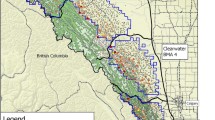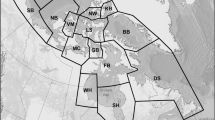Abstract
Solid understanding of species’ range and local population densities is important for successful wildlife management and research. Specific behavioral and ecological characteristics make brown bear Ursus arctos a difficult species to study. We present a map of range and local population densities of brown bears in Slovenia, made with the use of a new approach similar to voting classifications based on a combination of four datasets: Global Positioning System telemetry data, records of bear removals, systematic and opportunistic direct observations and signs of bear presence, and noninvasive genetic samples. Results indicate that the majority of bears in Slovenia live in Dinaric Mountains in the southern part of the country where local bear population densities exceed 40 bears/100 km2. This is one of the highest population densities reported so far for this species worldwide. Population densities decrease towards the north (Alpine region) and are very low along the border with Italy and Austria where almost no females are present. This explains slow past and present expansion of this transboundary bear population into the Alps and should be considered in future bear re-colonization management strategies. Results also showed that data from observations and removals overestimate bear population densities at low values, while mortality and genetic data overestimate population densities in areas with more people. Nevertheless, all data types appeared useful for describing the general bear distribution patterns. Similar approach could be applied to studies of other charismatic or game species, for which several types of data are often available.



Similar content being viewed by others
References
Adamič M (1992) Evaluation of possibilities for natural spreading of brown bear (Ursus arctos L.) toward the Alps, directions of main migration corridors and disturbances in their functioning. In: Adamič M (ed) Rjavi medved v deželah Alpe-Adria: zbornik posvetovanja, Ljubljana, 29. in 30. junija 1992, Ljubljana, Ministrstvo za kmetijstvo in gozdarstvo Republike Slovenije: Gozdarski inštitut Slovenije, pp 131–158 (in Slovenian)
Adamič M, Jerina K (2010) Ungulates and their management in Slovenia. In: Apollonio M, Andersen R, Putman R (eds) European ungulates and their management in the 21st century. Cambridge University Press, UK, pp 507–527
Apollonio M, Andersen R, Putman R (2010) European ungulates and their management in the 21st century. Cambridge University Press, UK
Bath A, Buchanan T (1989) Attitudes of interest groups in Wyoming toward wolf restoration in Yellowstone National Park. Wildl Soc Bull 17:519–525
Bath A, Majić A (2001) Human dimensions in wolf management in Croatia. Report, Large Carnivore Initiative for Europe. http://www.lcie.org/docs/hd/lcie%20bath%20croatia%20wolf%20hd%201.pdf. Accessed 8 May 2012
Bauer E, Kohavi R (1999) An empirical comparison of voting classification algorithms: bagging, boosting, and variants. Mach Learn 36:105–139
Boitani L (1995) Ecological and cultural diversities in the evolution of wolf–human relationships. In: Carbyn LN, Fritt SH, Seip DR (eds) Ecology and conservation of wolves in a changing world. Canadian Circumpolar Institute, University of Alberta, Edmonton, Alberta, Canada, pp 3–12
Boitani L, Ciucci P, Corsi F, Dupre E (1999) Potential range and corridors for brown bears in the Eastern Alps, Italy. Ursus 11:123–130
Clark JD (2009) Aspects and implications of bear reintroduction. In: Hayward MW, Somers M (eds) Reintroduction of top-order predators. Blackwell, Oxford, UK, pp 126–140
Clark JD, Huber D, Servheen C (2002) Bear reintroductions: lessons and challenges: invited paper. Ursus 13:335–345
Craighead JJ, Sumner JS, Mitchell JA (1995) The grizzly bears of Yellowstone: their ecology in the Yellowstone ecosystem, 1959–1992. Island Press, Washington, DC
Graves TA, Waller JS (2006) Understanding the causes of missed global positioning system telemetry fixes. J Wildl Manage 70:844–851. doi:10.2193/0022-541X(2006)70[844:UTCOMG]2.0.CO;2
Groff C, Dalpiaz D, Rizzoli R, Zanghellini P (2012) 2011 Bear report of the Forestry and Wildlife Department of the autonomous province of Trento. Autonomous Province of Trento, Trento
Guisan A, Zimmermann NE (2000) Predictive habitat distribution models in ecology. Ecol Model 135:147–186. doi:10.1016/S0304-3800(00)00354-9
Güthlin D, Knauer F, Kneib T, Kuchenhoff H, Kaczensky P, Rauer G, Jonozovič M, Mustoni A, Jerina K (2011) Estimating habitat suitability and potential population size for brown bears in the Eastern Alps. Biol Conserv 144(5):1733–1741. doi:10.1016/j.biocon.2011.03.010
Horne JS, Garton EO, Sager-Fradkin KA (2007) Correcting home-range models for observation bias. J Wildl Manage 71:996–1001
Huber D, Roth HU (1993) Movements of European brown bears in Croatia. Acta Theriol 38:151–159
Hullermeier E, Vanderlooy S (2010) Combining predictions in pair wise classification: an optimal adaptive voting strategy and its relation to weighted voting. Pattern Recogn 43:128–142. doi:10.2193/2005-678. doi:10.1016/j.patcog.2009.06.013
Jerina K (2012) Roads and supplemental feeding affect home-range size of Slovenian red deer more than natural factors. Journal of Mammology 93:1139–1148
Jerina K, Adamič M (2008) Fifty years of brown bear population expansion: effects of sex-biased dispersal on rate of expansion and population structure. Journal of Mammology 89:1491–1501. doi:10.1644/07-MAMM-A-357.1
Jerina K, Debeljak M, Dzeroski S, Kobler A, Adamič M (2003) Modeling the brown bear population in Slovenia—a tool in the conservation management of a threatened species. Ecol Model 170:453–469. doi:10.1016/S0304-3800(03)00245-X
Jerina K, Krofel M, Stergar M, Videmšek U (2012) Factors affecting brown bear habituation to humans: a GPS telemetry study. Final report—summary for users. University of Ljubljana, Biotechnical Faculty, Ljubljana
Kaczensky P, Blazic M, Gossow H (2004) Public attitudes towards brown bears (Ursus arctos) in Slovenia. Biol Conserv 118:661–674
Kaczensky P, Jerina K, Jonozovič M, Krofel M, Skrbinšek T, Rauer G, Kos I, Gutleb B (2011) Illegal killings may hamper brown bear recovery in the Eastern Alps. Ursus 22(1):37–46
Kavčič I, Adamič M, Krofel M, Jerina K, Kaczensky P (2011) Brown bear food habits in human dominated landscapes of Slovenia: importance of intensive long-term supplemental feeding. 20th International conference on bear research and management, Ottawa, pp 162-163
Kendall KC, Stetz JB, Roon DA, Waits LP, Boulanger JB, Paetkau D (2008) Grizzly bear density in Glacier National Park, Montana. J Wildl Manag 72:1693–1705
Kendall KC, Stetz JB, Boulanger J, Macleod AC, Paetkau D, White GC (2009) Demography and genetic structure of a recovering grizzly bear population. J Wildl Manag 73(1):3–17
Kobler A, Adamič M (2000) Identifying brown bear habitat by a combined GIS and machine learning method. Ecol Model 135:291–300. doi:10.1016/S0304-3800(00)00384-7
Krebs CJ (2009) Ecology: the experimental analysis of distribution and abundance, 6/E. University of British Columbia, Vancouver
Krofel M, Filacorda S, Jerina K (2010) Mating-related movements of male brown bears on the periphery of an expanding population. Ursus 21:23–29. doi:10.2192/09SC015.1
Krofel M, Jonozovič M, Jerina K (2012) Demography and mortality patterns of removed brown bears in a heavily exploited population. Ursus 23:91–103. doi:10.2192/URSUS-D-10-00013.1
Mace RD, Waller JS (1998) Demography and population trend of grizzly bears in the Swan Mountains, Montana. Conser Biol 12:1005–1016. doi:10.1046/j.1523-1739.1998.97031.x
MAPDR, MMGA (2005) Management and action plan for the bear population in Romania. Ministry of Agriculture, Forestry and Rural Development and Ministry of Environment and Water Management. http://www.mmediu.ro/file/Management_Action_Plan.pdf. Accessed 1 September 2012
McLellan BN (1989) Dynamics of a grizzly bear population during a period of industrial resource extraction. I. Density and age sex composition. Can J Zool 67:1856–1860. doi:10.1139/z89-264
Mech LD, Boitani L (2003) Wolves: behavior, ecology, and conservation. The University of Chicago Press, Chicago, IL
Ordiz A, Støen OG, Delibes M, Swenson JE (2011) Predators or prey? Spatio-temporal discrimination of human-derived risk by brown bears. Oecologia 166(1):59–67. doi:10.1007/s00442-011-1920-5
Preatoni D, Mustoni A, Martinoli A et al (2005) Conservation of brown bear in the Alps: space use and settlement behavior of reintroduced bears. Acta Oecologica 28:189–197
Rigg R, Adamec M (2007) Status, ecology and management of the brown bear (Ursus arctos) in Slovakia. Slovak Wildlife Society, Liptovský Hrádok
Simonič A (1994) The legal protection of the brown bear in Slovene territory—past and present, and some suggestions for the future. In: Adamič M (ed) Rjavi medved v deželah Alpe-Adria, Zbornik posvetovanja. Ministrstvo za Kmetijstvo in Gozdarstvo RS, Gozdarski inštitut Slovenije, Ljubljana, pp 11–75
Skrbinšek T, Jelenčič M, Potočnik H, Trontelj P, Kos I (2008) Analiza medvedov odvzetih iz narave in genetsko-molekularne raziskave populacije medveda v Sloveniji. I. Del. Varstvena genetika in ocena številčnosti medveda 2007. Final report. University of Ljubljana, Biotechnical Faculty, Ljubljana (in Slovenian)
Skrbinšek T, Jelenčič M, Waits LP, Kos I, Trontelj P (2009) Highly efficient multiplex PCR of noninvasive DNA does not require preamplification. Mol Ecol Resour 10:495–501. doi:10.1111/j.1755-0998.2009.02780.x
Solberg KH, Bellemain E, Drageset OM, Taberlet P, Swenson JE (2006) An evaluation of field and non-invasive genetic methods to estimate brown bear (Ursus arctos) population size. Biol Conserv 128:158–168. doi:10.1016/j.biocon.2005.09.025
Steyaert SMJG, Endrestøl A, Hackländer K, Swenson JE, Zedrosser A (2012) The mating system of the brown bear Ursus arctos. Mammal Rev 42(1):12–34. doi:10.1111/j.1365-2907.2011.00184.x
Støen O-G, Zedrosser A, Saebo S, Swenson JE (2006) Inversely density-dependent natal dispersal in brown bears Ursus arctos. Oecologia 148:356–364. doi:10.1007/s00442-006-0384-5
Swenson JE, Sandegren F, Soderberg A (1998) Geographic expansion of an increasing brown bear population: evidence for presaturation dispersal. J Anim Ecol 67:819–826. doi:10.1046/j.1365-2656.1998.00248.x
Wielgus RB, Bunnell FL (1994) Dynamics of a small, hunted brown bear Ursus arctos population in southwestern Alberta, Canada. Biol Conserv 67:161–166. doi:10.1016/0006-3207(94)90362-X
Wielgus RB, Bunnell FL (2000) Possible negative effects of adult male mortality on female grizzly bear reproduction. Biol Conserv 93:145–154. doi:10.1016/S0006-3207(99)00152-4
Zedrosser A, Dahle B, Swenson JE, Gerstl N (2001) Status and management of the brown bear in Europe. Ursus 12:9–20
Acknowledgments
Financial support for the study was provided by the Environmental Agency of the Republic of Slovenia and by the European Commission under the seventh Framework Programme for Research and Technological Development (project “HUNTing for sustainability”). The views expressed in this publication are the sole responsibility of the authors and do not necessarily reflect the views of the European Commission. For help with data acquisition, we are grateful to colleagues from the Slovenian Hunters’ Association and Slovenia Forest Service.
Author information
Authors and Affiliations
Corresponding author
Additional information
Communicated by A. Aguirre
Rights and permissions
About this article
Cite this article
Jerina, K., Jonozovič, M., Krofel, M. et al. Range and local population densities of brown bear Ursus arctos in Slovenia. Eur J Wildl Res 59, 459–467 (2013). https://doi.org/10.1007/s10344-013-0690-2
Received:
Revised:
Accepted:
Published:
Issue Date:
DOI: https://doi.org/10.1007/s10344-013-0690-2




